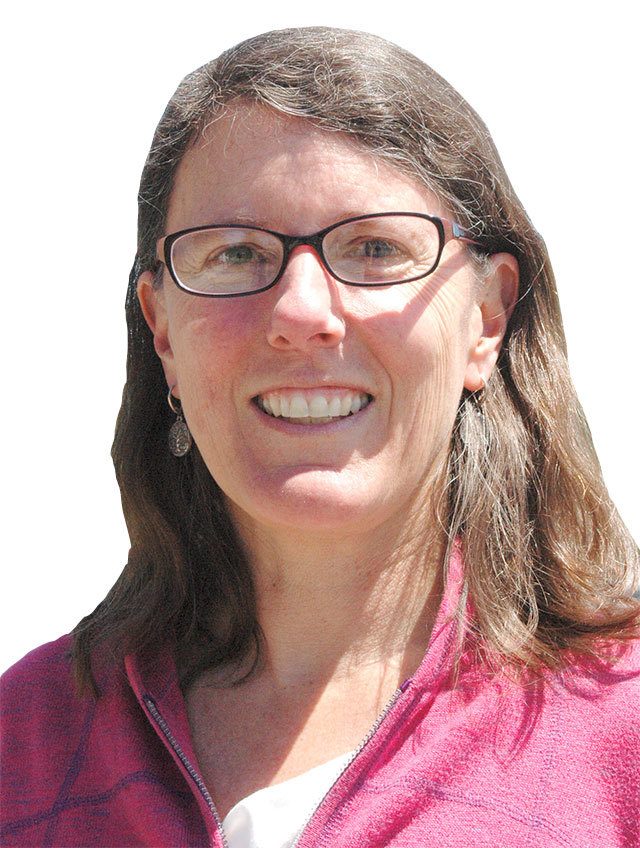If you were around here 20 years ago, do you remember Bell Creek actually running all summer? If you were in grade school then, did your class raise salmon fry and release them into Bell Creek behind Les Schwab?
I have photos somewhere of that awesome scene: a line of school buses and hundreds of small children stepping out carrying Dixie cups of water with baby salmon, walking gingerly to the stream’s edge and pouring their precious cargo into the stream.
The fish habitat in that reach had been recently restored when Les Schwab built—but I’m sure those kids didn’t realize that the water flowing at that time was for irrigation, diverted from the Dungeness River between April and September to serve farms near Carrie Blake Park. Within a few years the push to conserve streamflow in the Dungeness for salmon spawning in late summer resulted in major changes in water management, including discontinuing use of the Bell Creek channel.
I sometimes wonder if those kids worried about their fish’s fate when, by the time they reached high school, the creek’s restored meanders and log jams behind Les Schwab were sitting high and dry all summer. Maybe they’d be relieved to know that coho and steelhead are indeed found in lower Bell Creek each spring, when the Jamestown S’Klallam Tribe captures and counts “smolts” before they migrate out to saltwater.
Of course, without irrigation water the ponds at Carrie Blake Park also would dry up — so the City stepped in. Starting around 2000, reclaimed water from the wastewater treatment plant near Sequim Bay was piped uptown and to the new “Water Reuse Demonstration Site” on the north side of Bell Creek at the park.
In addition to irrigating grass and landscaping, flushing toilets and filling the fishing pond, reclaimed water was now delivered to the ponds in Carrie Blake, ensuring a continuous water supply for the ducks and enduring beauty for the Friendship Pond.
Most of Bell Creek’s four miles are inside the city limits — and the examples above show how much of the creek’s history is directly tied to the history of our hometown.
Bell Creek’s headwaters gather in Happy Valley from rivulets off Burnt Hill and Bell Hill, and as far to the east as the divide with Johnson Creek. After these tributaries merge, the creek feeds the large wetland on the south side of Happy Valley Road just before it plunges downhill parallel to Third Avenue.
A walk into the woods at Sequim’s Gerhardt Park (1610 S. Third Ave.) leads to a view of Bell Creek’s impressive canyon. With some old growth it has the feel of primitive forest and gives one a sense of what the area must have looked like 200 years ago. The depth of the canyon surprises, given the small stream rippling below.
The next place we can see Bell Creek is at Brownfield Road just before it crosses under Highway 101. In my three years of watching, this is the peek-a-boo zone where “now you see it, now you don’t.” While a trickle persists under Brownfield well into summer, the channel just downstream of the bypass is dry most of the year.
I and my storm-chasing volunteers checked this out many times last year and were continually amazed at the water-holding capacity of the bathtub of gravel under the Sequim Avenue interchange. The 1859 government maps indicate a wetland at this location, but the label “sponge” would be even more appropriate!
This absorptive capacity is an example of the so-called “ecosystem services” provided by the natural environment. In this case, a geologic sponge serves to filter and recharge the aquifer system — at no cost to all of us well-water drinkers, assuming we protect it!
The Sequim Sponge intercepts runoff coming off the foothills in the same way that floodplains function everywhere — absorbing high flows, slowing the runoff, preventing erosion and capturing contaminants. There’s a tipping point after which the geology can’t take in any more water and the creek rises.
For the perennial ponds at Carrie Blake, the sponge at Sequim Avenue and that salmon really do spawn downstream, Bell Creek is a superstar for water management in Sequim. The “Belle of the Ball” — our hometown stream we can take pride in.
Contest, con’t
In the last Water Matters column on Nov. 30, I described Bell Creek’s ephemeral nature and announced a contest to guess the date it starts flowing into Carrie Blake Park for the season. Continuous flow, that is: flash floods and stagnant pools notwithstanding. It happens at some point each winter, usually between November and January.
As of Dec. 23, the channel is flowing!
Take a ‘tour’
How did Bell Creek’s deep ravine originate? Learn this and more on the “Bell Creek Discovery Tour,” taken online or on-foot — a great outdoors activity with kids or without! See www.sequimwa.gov/index.aspx?NID=676.
Geek Moment
For the 2017 water year (started Oct. 1), on Nov. 27, cumulative rainfall in Sequim = 5.9 inches; snowpack at the Dungeness SNOTEL station (4,000’ elev.) = 17 inches, snow water equivalent
= 3.9 inches (long term median = 2.5 inches).
For 12/22/16, Dungeness River streamflow at Mile 11.8 = 220 cubic feet per second (cfs). Bell Creek flow at North Blake Avenue = 0 (dry); at the mouth = ~1.3 cfs.
Ann Soule is a licensed hydrogeologist immersed in the Dungeness watershed since 1990. She is now resource manager for City of Sequim. Reach Ann at columnists@sequimgazette.com or via her blog of Gazette articles @watercolumnsite.wordpress.com.



